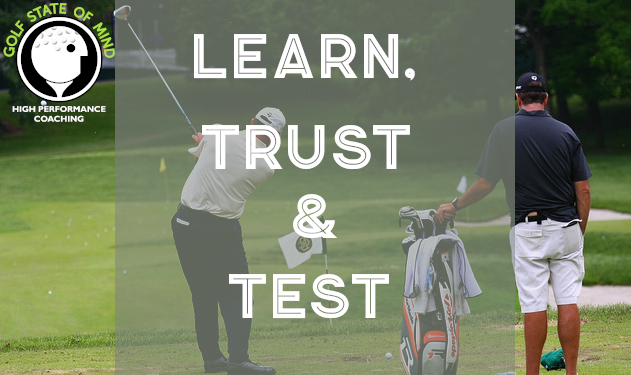
Once you’ve set your “performance goals”, then you can get to work on setting your “process goals” for your practice regimen. In the practice module of the “Ultimate Mental Game Training System” I have plenty of these process goals (which includes reps for mostly variable and performance practice). Process goals would be the actions/steps required to achieve your performance goals e.g. technical improvements to the swing, fitness work, a better pre-shot routine, improved distance control with putting, etc. Set out a plan and hold yourself accountable to it.
Learn, Trust and Test…
The cycle that I recommend that you go through while practicing is called Learn, Trust and Test. During the Learn phase, we are learning how to improve our technical skills. During the Trust phase of practice, we are developing trust in those skills, and then in the Test phase, we are going to Test the skills with pressurized or “performance” practice. You’re far better off testing your game in practice, than you are on the course!
Gone are the days, where you just show up at the range and search for something to work on, and then spend the whole session focusing on technique. Instead, we’re going to use stats (evidence) and a structured, effective practice plan to guarantee improvement. Success will come only when you do the right things, repeatedly and patiently.
The amount of time spent in each of the 3 phases of practice will vary from player to player, depending on skill level. I.e. a beginner would spend more time in the Learn phase than a Tour pro, who should (even at this level many can overdo technical training) be doing much more “performance practice” or Test phase, with tight constraints. Here’s an example of how a 90 min practice session could look for a 9 handicapper:
Learn
The 9 handicap player has identified “Greens Hit In Regulation” as the biggest opportunity to score better. Let’s assume that they have kept stats for their last 5-10 rounds, so they have a good idea of their misses and the amount of improvement they’d like to make over the next 8-12 weeks. Their swing coach should be able to tell them the most likely cause of the miss/wide dispersion and what technical improvements they can make. Let’s say for this player that it could be getting the club more inside their current downswing plane, to reduce the left miss (pull), which they have noticed. During a 90 min practice session, the player might spend 30 mins focusing solely on the drills that their coach has deemed to be the most effective in correcting the fault. In this case it could be drills to “shallow the plane” to get the swing path more in-to-out on the downswing. This 30 minutes of the Learn phase would be spent making repetitive actions with the same club and same target and learning the new movement pattern. With reps over 8-12 weeks, this should transfer into the swing on the course.
Trust
After 30 minutes of technical practice solely focused on that particular aspect of the swing, the player would move onto Variable, or Trust practice, where he/she would hit a variety of different iron shots to different targets/distances (100, 125, 150, 175, etc.) E.g. low/medium/high shots with draw/straight/fade shape to different targets. No two shots should be the same in Trust practice. The purpose of this type of practice is to not just take focus away from the swing (and just trust it), but to help the player develop a better understanding of what produces different shot shapes and trajectories and increase their awareness and athletic ability. During this type of practice we improve playing skills and shot making skills, by using visualization, feel and tempo (playing sensory golf). The brain creates stronger neural pathways (skills) when it has to work for it, instead of making repetitions of the same swing.
Test
The final phase of practice (for this player the last 30 minutes) is the Test phase where the player would be doing Performance Drills, or challenges. An example for this player to improve Greens Hit In Regulation, would be setting proximity to the hole constraints for different targets e.g. Getting 5 shots within x ft from 100 yards, 5/6 balls within x ft from 125 yards, 4/6 balls within x ft from 150 yards and 3/6 from 175 yards (x would be dependent on skill level). This game could be make more difficult by not hitting the same shot twice, so hitting one shot from 100 yds and the next shot from 125 yds and so on…
The purpose of the Test phase is to increase pressure on the player and make practice hard (the player should go through their full shot routine for each shot, so they train their focus), and build confidence from completing challenges which can get increasingly harder each week.
Of course there are hundreds of different games and challenges to improve all areas of the game, plenty of which you will find in the Ultimate Mental Game Training System, along with 7 modules to practice your Mental game skills on and off the course.


